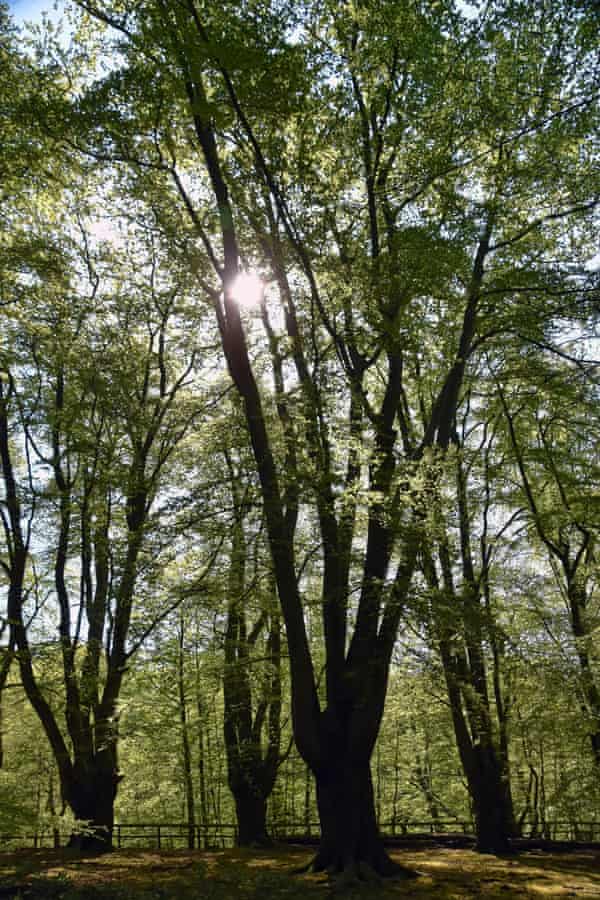Where Can I Buy Taste of the Wild Near Me
West hy can't we communicate with trees the same manner nosotros communicate with, say, elephants? Both alive in social groups and look afterwards not only their young but as well their elders. That famous elephant memory is also institute in copse, and both communicate in languages that we didn't even recognise at first. Trees communicate through their interconnected root systems, and elephants communicate using low-frequency rumbling below the range at which we tin hear. We get a feeling of wellbeing when we run our fingers over the rough pare of both creatures, and what we would love above all is to get a reaction from them.
Is such advice possible between people and trees? First nosotros accept to have a closer look at what nosotros mean by "communicate". It is not enough that we consciously or subconsciously eavesdrop, so to speak, on the scents copse use to communicate among themselves. We accept a concrete reaction when we breathe them in, but for communication to happen, the trees also need to react to our signals.

Copse transpire chemical compounds. We are subconsciously enlightened of these compounds and we respond with changes in blood pressure level. The tree, for its part, is unaware of our response – after all, we are not in contact with the tree in any manner. And fifty-fifty if we hug the tree and talk of electric fields, which is one way we could mutually bear upon each other (considering plants, like united states, function partially by transmitting electric signals), at that place is still one huge obstacle: time. Trees, every bit we all know, are clumsily irksome. You can multiply the time information technology takes you to brand contact with the tree by 10,000 to find out when you can expect a response.
Trees store memories, respond to attacks and transfer carbohydrate solution, and perhaps even memories, to their offspring. All these abilities suggest that they must as well have a encephalon. Just no one has even so found any such thing. Professor František Baluška at the Academy of Bonn has recently been looking into this. For some time now, he has been of the stance that plants are intelligent – after all, they tin process information and make decisions – just consciousness takes the discussion to a unlike level.
Baluška and his colleagues sedated plants that feature moving parts, such as Venus flytraps. The anaesthetics the scientists used deactivated electrical activity so that the traps no longer reacted when they were touched. Sedated peas showed similar changes in behaviour. Their tendrils, which normally move in all directions, stopped searching and started to spiral on the spot. Subsequently the plants broke the narcotics down, they resumed their normal behaviour.
Did the plants wake upwards as nosotros do when we come to after a general anaesthetic? This is the disquisitional question, because in order to wake up, you need one affair above all others: consciousness. And it was exactly this question that a reporter posed to Baluška. I really liked his answer: "No one can reply this because you cannot ask [the plants]."
When y'all hug a tree, nothing electric happens, because your voltages are the aforementioned. Simply might the tree be aware of your impact in some other way? All yous have to do, for example, is stroke your love apple plants for a few minutes each day and they slow their upward growth and put their free energy into growing thicker stems instead. This, still, is not the plant saying information technology loves you besides, but rather the constitute reacting to what it probable experiences as a cakewalk blowing by, because the wind elicits a like response. If you lot were hoping to hug a tree and go a hug back, this information must be disappointing.
Nosotros practice, nevertheless, discover a great deal of sensitivity in a completely different role of the tree: its roots. At this level, the tree works its mode through the ground with its root tips, which incorporate brain-similar structures. The root tips feel, taste, examination and decide where and how far the roots will travel. If there is a stone in the style, the sensitive tips notice and choose a different route. The sensitivity to affect that tree lovers are seeking is therefore to be found not in the trunk but underground. If it is possible to make contact, the roots would be the first place to try. Notwithstanding, they similar neither pressure nor fresh air – and then there'southward no point exposing these tender structures, because fifty-fifty x minutes in the sun spells expiry for their tissue.
The near recent scientific discoveries, however, offer something completely dissimilar: the heartbeat of copse.
What claret is to people, water is to copse. I accept written a lot virtually how h2o is transported upward into the crown of the tree; exactly how that happens has non yet been adequately explained. Only Dr András Zlinszky at the Balaton Limnological Found in Tihany, Hungary, is shedding some light on the matter. Some years agone, he and colleagues from Finland and Austria noticed that birch copse announced to balance at night. The scientists used lasers to measure trees on calm nights. They noticed the branches hung upwardly to 4in (10cm) lower, returning to their normal position when the sunday rose. The researchers started talking well-nigh sleep behaviour in trees.
Zlinszky could non become this discovery out of his caput, and he decided he needed to investigate farther. He and a colleague, Professor Anders Barfod, measured some other 22 trees of different species. Over again, they documented the rise and fall of the branches, only this time some of the cycles were different. The branches changed position not only morning and night, but also every three to four hours. Was it conceivable that the trees were making pumping movements at these regular intervals? Afterwards all, other researchers had already determined that the diameter of a tree's body sometimes shrinks by well-nigh 0.002in (0.05mm) before expanding once more. Were the scientists on the trail of a heartbeat that used contractions to pump water gradually upward? A heartbeat so slow that no i had noticed information technology before? Zlinszky and Barfod suggested this as a plausible caption for their observations, nudging trees 1 step farther toward the brute kingdom.

A heartbeat every three to four hours is, unfortunately, as well slow for even the most sensitive person to experience when they hug a tree. Only there is one last possible way to connect with trees: our voices. Can plants hear? I tin answer without hesitation in the affirmative. This was tested years agone with Arabidopsis, a genus of rockcress dearest of scientists. Beloved considering it grows well, it reproduces rapidly, and it's easy to keep track of its genes. Scientists discovered that the roots of Arabidopsis oriented themselves toward clicks in the frequency of 200Hz and so grew in that direction.
Arabidopsis also seems to react to the nibbling of caterpillars, an ominous sound to plants of all species. Researchers at the University of Missouri put caterpillars on samples of the plants. The vibrations caused by the caterpillars munching were enough to shake the plants' stems, and the researchers used light amplification by stimulated emission of radiation beams to record the vibrations. When researchers then played these vibrations to plants that were not being eaten, they produced peculiarly large quantities of defensive chemicals when they were later attacked. Wind and other sounds with the same frequency did not elicit a reaction. Arabidopsis, then, can hear, and this makes perfect sense. Thanks to acoustic warnings, it is able to recognise danger some distance abroad, so it can brand appropriate preparations to defend itself. What is particularly of import here is that the plants ignore noises that pose no threat to them. These noises probably include human voices. What a shame.
I can well understand people's desire to communicate with copse. To sit under these giants, run your hands over their bark, and feel secure – all this would be even more special if there were an active, positive response to your presence or, even better, to your touch. I am not going to deny that something like that might be possible, but conservative science at to the lowest degree has no proof that information technology could happen. And even if this were the last discussion on the subject, does the tree have to respond? Could information technology not exist that people and copse alive in completely different worlds? Later all, our species has existed for only 0.1% of the time that trees have been around. For the fourth dimension being, it should be enough that we experience expert around trees – and I hope we can then exist content to allow them to alive their own wild lives.
Although trees may experience nothing of our attempts to communicate, we, for our function, definitely experience a physical reaction. I encourage you lot to experience this for yourself. Make a programme to go exterior and immerse yourself in nature. If at that place is a wood nigh you, make that your destination. If you lot live in a city, find a park or even simply a tree-lined street where yous can take a walk. Stand up and feel the air on your skin. What tin can yous smell? The gentle, bawdy aromas of old leaves gently decomposing on the ground or the tangy, brisk scents of new growth? What can yous hear? The scratching of squirrels scuttling up trunks or the rustle of leaves as birds turn them over to discover insects underneath? Shut your eyes and feel that this is a place where you belong.
Take a moment to merely sit down – on a stump or a log or a carpet of leaves. Does that bring you fifty-fifty closer to feeling function of the wood? Run your fingers through the crispness of leaves or over the softness of moss. What practice you know about the trees and plants effectually you? Do yous know their names? Do y'all know if they are rubber to eat and, if they are, how they gustation? What more than would you like to learn most their lives, what would you lot hope to find in guide books and what do you hope scientists will explore in the hereafter then nosotros can really get to know the astonishing creatures that are trees in all their biological complexity? Nosotros share a earth and if they thrive, so do we.
morganroublet1998.blogspot.com
Source: https://www.theguardian.com/books/2021/may/28/branching-out-is-communication-possible-between-trees-and-people
0 Response to "Where Can I Buy Taste of the Wild Near Me"
Postar um comentário